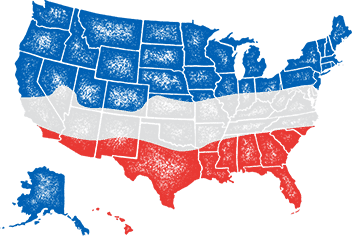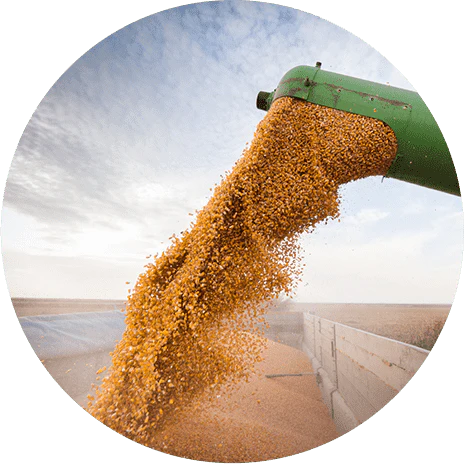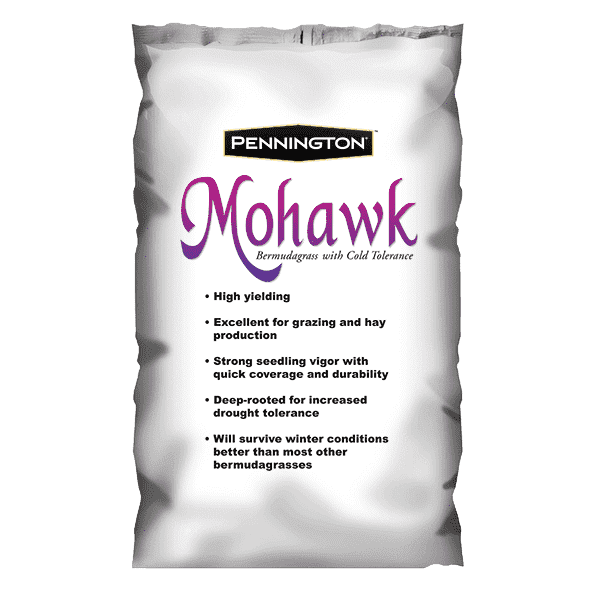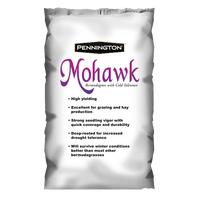
- When to plant:
- Spring, Summer
- Fertilizer:
- Hancock's 16-04-08 Lawn & Pasture Fertilizer
- Seeding rate:
- 15 - 20 lbs. per acre
- Overseeding rate:
- 8 - 12 lbs. per acre
- Seeding rate drilling:
- 15 - 20 lbs. per acre
- Seeding depth:
- 1/8 inch
- Ideal ph:
- 5.5 - 7.0
- Gmo:
- No
- Inoculant needed:
- No
- Coated or raw:
- Coated
- Lifecycle:
- Perennial
- Climate zones:
- Transition Zone, Warm Season
Bermuda Grass can make for a heck of a lawn, but sometimes you want a tough strain like Mohawk Bermuda Grass Seed to provide both pasture and hay opportunities for your herds. This is an optimal grazing option for all ranchers across the southern third of the United States.
Product Information
- Application or Use: Pasture, Cattle Grazing, Livestock Forage, Cover Crop, Hay Production
- Germination Time: 5 - 12 days, under optimal conditions
- Growing Locations: Warm Season & Transition Zone
- Height: Grazing or Hay Cutting, 8 - 10 inches
- Sunlight Requirements: 8+ hours, full sun for best results
- Advantages: Strong seedling vigor, quick coverage, and extreme traffic durability.
- When to Plant: Recommended planting time is spring and summer when nighttime temperatures are consistently 65+ degrees and 3 months prior to first frost.
Product Detail
- Dark green color
- Medium-fine texture
- Cold tolerant
- Drought resistant
- Pasture grazing and hay production
Product Information
Mohawk Bermuda Grass Seed is a cold-tolerant, drought-resistant advanced Bermuda Grass Seed variety with increased sod density, combined with medium-fine texture and dark green color. Mohawk Bermuda Grass can be used, under good management practices, for both grazing and hay production throughout the spring and summer months.
Since 1993, Mohawk Bermuda Grass Seed has delivered improved performance and cold tolerance in Virginia trials. Mohawk Bermuda was developed for pasture and hay production in the southern and central climates. Mohawk is a tough, durable, high-quality, high-yielding forage and hay-type Bermuda Grass for the tropical and subtropical growing areas around the world.
Mohawk Bermuda grass is well-suited to sandy soils but will thrive in most well-drained loam soils.
Mohawk Bermuda Grass Seed thrives across the southern 1/3 of the United States. from California to Virginia.
*Product packaging may appear different than what is pictured.
Plant during late spring through early summer, when soil temperatures are 65°F or above. Plow and cultipack to develop a firm seedbed. Proper firmness is indicated by a heel print no more than 1/8" deep in the soil. Plant at a maximum of 1/4 inch depth.
Due to varying soil conditions and types, it is necessary to conduct a soil test each year in order to supply the proper nutrients. Apply 20-30 lbs. of nitrogen at planting time. When the new plants start to run, apply 50-60 lbs. of nitrogen. After the stand is established, apply 70-100 lbs. of nitrogen after each cutting.
If grazed, apply up to 150 lbs. of nitrogen per year in split applications throughout the summer. The last fertilizer application of each year should be done 4 to 6 weeks before a killing frost, to increase cold tolerance. Delay grazing until forage is 8 to 10 inches tall. Do not graze or clip for hay shorter than 2 inches. Rotate animals more often during periods of drought stress.
When choosing to start a new lawn, remove old vegetation by using a de-thatcher, power rake or tiller to kill the existing vegetation. Rake or drag the area to remove debris and dead grass for a clean area. Ensure the soil is leveled and loosened to allow the seed to have good soil contact once spread on a clean seed bed.
If you have an area with heavy weed coverage, we recommend starting fresh by killing and removing the existing vegetation. If you choose to use chemicals, herbicides or fertilizers, you must check with the product's manufacturer prior to planting new seed to ensure the proper waiting period.
When overseeding an existing area, mow your lawn at the lowest setting and bag the clippingsx. Rake or drag any areas that have dead thatch or debris.

Seed Quality
Hancock Seed is dedicated to delivering the best seeds possible to our customers. Hancock Seed grows and harvests many of our products, and we acquire the majority of the rest from other family farmers.
All these seeds are processed, packaged and shipped from Hancock Farm. This helps us ensure that our high standards are met. Unlike much of the competition, we refuse to sell you a seed that was not gathered during the last harvest. You will always receive fresh product from Hancock.
Every seed we grow comes with 40 years of experience behind it...you can rest assured that all of our products are cultivated in a method that assures its potential for growth.

Your cart ( 0 )

Bermuda Grass can make for a heck of a lawn, but sometimes you want a tough strain like Mohawk Bermuda Grass Seed to provide both pasture and hay opportunities for your herds. This is an optimal grazing option for all ranchers across the southern third of the United States.
Product Information
- Application or Use: Pasture, Cattle Grazing, Livestock Forage, Cover Crop, Hay Production
- Germination Time: 5 - 12 days, under optimal conditions
- Growing Locations: Warm Season & Transition Zone
- Height: Grazing or Hay Cutting, 8 - 10 inches
- Sunlight Requirements: 8+ hours, full sun for best results
- Advantages: Strong seedling vigor, quick coverage, and extreme traffic durability.
- When to Plant: Recommended planting time is spring and summer when nighttime temperatures are consistently 65+ degrees and 3 months prior to first frost.
Product Detail
- Dark green color
- Medium-fine texture
- Cold tolerant
- Drought resistant
- Pasture grazing and hay production
Product Information
Mohawk Bermuda Grass Seed is a cold-tolerant, drought-resistant advanced Bermuda Grass Seed variety with increased sod density, combined with medium-fine texture and dark green color. Mohawk Bermuda Grass can be used, under good management practices, for both grazing and hay production throughout the spring and summer months.
Since 1993, Mohawk Bermuda Grass Seed has delivered improved performance and cold tolerance in Virginia trials. Mohawk Bermuda was developed for pasture and hay production in the southern and central climates. Mohawk is a tough, durable, high-quality, high-yielding forage and hay-type Bermuda Grass for the tropical and subtropical growing areas around the world.
Mohawk Bermuda grass is well-suited to sandy soils but will thrive in most well-drained loam soils.
Mohawk Bermuda Grass Seed thrives across the southern 1/3 of the United States. from California to Virginia.
*Product packaging may appear different than what is pictured.
Plant during late spring through early summer, when soil temperatures are 65°F or above. Plow and cultipack to develop a firm seedbed. Proper firmness is indicated by a heel print no more than 1/8" deep in the soil. Plant at a maximum of 1/4 inch depth.
Due to varying soil conditions and types, it is necessary to conduct a soil test each year in order to supply the proper nutrients. Apply 20-30 lbs. of nitrogen at planting time. When the new plants start to run, apply 50-60 lbs. of nitrogen. After the stand is established, apply 70-100 lbs. of nitrogen after each cutting.
If grazed, apply up to 150 lbs. of nitrogen per year in split applications throughout the summer. The last fertilizer application of each year should be done 4 to 6 weeks before a killing frost, to increase cold tolerance. Delay grazing until forage is 8 to 10 inches tall. Do not graze or clip for hay shorter than 2 inches. Rotate animals more often during periods of drought stress.
Instructions
When choosing to start a new lawn, remove old vegetation by using a de-thatcher, power rake or tiller to kill the existing vegetation. Rake or drag the area to remove debris and dead grass for a clean area. Ensure the soil is leveled and loosened to allow the seed to have good soil contact once spread on a clean seed bed.
If you have an area with heavy weed coverage, we recommend starting fresh by killing and removing the existing vegetation. If you choose to use chemicals, herbicides or fertilizers, you must check with the product's manufacturer prior to planting new seed to ensure the proper waiting period.
When overseeding an existing area, mow your lawn at the lowest setting and bag the clippingsx. Rake or drag any areas that have dead thatch or debris.


















